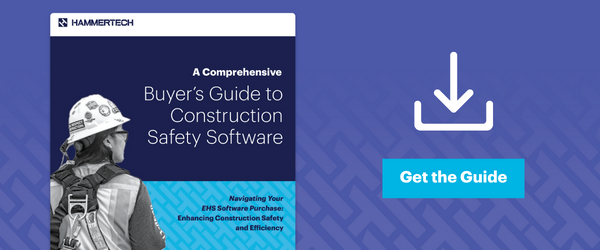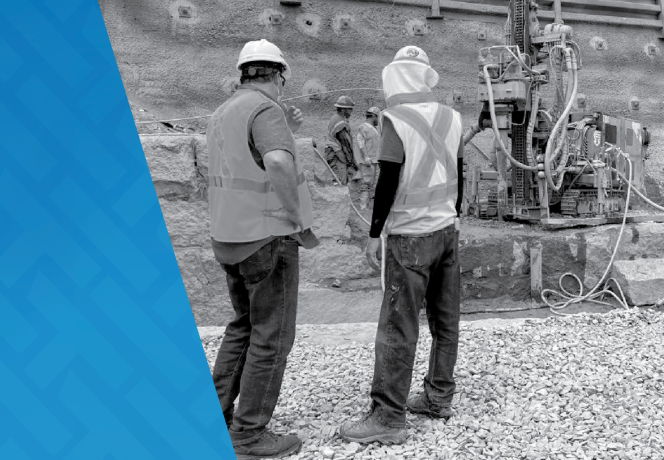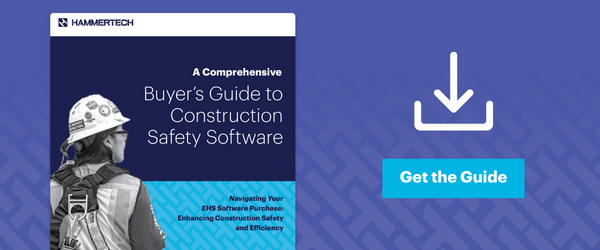The construction landscape is shifting. In an era marked by technological advancements and increased environmental, health, and safety (EHS) considerations, the traditional approach is no longer good enough.
Enter the recent AGC Safety, Health and Environmental Conference in Nashville, a vibrant melting pot of industry insight, where leaders and innovators explore the integration of technology in construction.
One of the stand out conversations that took place explored how construction companies can prepare for the perfect rollout of EHS software solutions to help with the mission to build safer. With contributions from leading voices like Chelsea Lindberg from Shawmut Design and Construction, Alissa Lackey from DPR Construction, and James Alexander and Dylan Hipple from HammerTech, the message was clear: In an industry that must continually adapt to survive, embracing innovative EHS software solutions is not merely a trend—it's a necessity.
Defining Your Software Needs: Tailoring Solutions for Success
When it comes to EHS software, tailored solutions often spell the difference between success and mediocrity. The panel at AGC Nashville discussed how businesses can find the perfect match:
Identifying Needs: Beyond Checklists
The needs of commercial and infrastructure contractors compared with residential builders or even broad corporations that operate across multiple sectors are vastly different. Checklists and auditing alone are insufficient for managing safety on complex projects which require construction specific risk management and subcontractor engagement processes. By understanding your needs and requirements, you can find the EHS software that is right for you.
-
Tip: Consider conducting a SWOT (Strengths, Weaknesses, Opportunities, Threats) analysis of your current processes to identify areas for improvement. These insights can guide the selection of software that genuinely enhances your business.
Value Recognition: Creating Buy-in
EHS software can help you improve productivity and efficiency by automating tasks, such as incident reporting, hazard identification, and compliance documentation. This can free up your time and resources so you can focus on other important things. By converting these advantages into real-world benefits, it's easier to secure buy-in from different stakeholders.
-
Tip: Develop a presentation that visualizes potential benefits, whether it's cost savings, increased safety, or more efficient resource allocation. Make the advantages tangible to facilitate value recognition across all levels of your organization like the field and executive leadership.
Align with Company Goals: A Cohesive Strategy
If your company's primary objective for the year is to reduce workplace accidents or improve efficiency, ensure that the new software's features align with this goal, such as by offering access to leading indicators like worker license and certifications or pre-task plan completion rates. EHS software can also help you track employee training records and certifications. This can help you ensure that your employees are up-to-date on the latest safety procedures.
-
Tip: Consult with various departments to understand their unique goals and find software that bridges the needs of different aspects of your business.
Think Big Picture: A Vision for Growth
Consider how the new software will adapt to future expansions or changes within your company. Can it integrate with other tools you might adopt down the line? Is it scalable?
-
Tip: Look for software with robust support and a strong development roadmap to ensure that it evolves along with your company's needs.
The Importance of a Phased Implementation
The transition to new EHS software can be complex. Just like constructing a new project, it needs a sturdy foundation, careful planning, strong stakeholder engagement and execution in phases. With a strong plan you’ll maintain momentum and see value sooner.
Start Slow: Managing Risks
Select projects or a region with leaders who have a reputation for excellence or are looking for new ways of working. This allows for closer communication with a smaller group of stakeholders so that you can adjust processes, measure against success indicators like engagement rates and take learnings before taking it to the broader organization.
-
Tip: Create a roadmap detailing each phase of implementation, complete with timelines, responsibilities, and expected outcomes.
Setting Clear Benchmarks for Success: Measure to Improve
The beauty of defined benchmarks for technology implementation is that success becomes a tangible, reachable target. The AGC panel drove this point home by emphasizing the following:
Clear Metrics: Defining Success
If cost savings is a key goal, set precise targets like a 15% reduction in operational expenses over six months. Set-up reports to monitor these metrics prior to implementation and review the results with key stakeholders regularly..
-
Tip: Regularly review your set benchmarks and adjust them as needed. Continual improvement is as vital as reaching the initial goal.
Tangible Benefits: More than Tools
EHS software can do much more than just improve site safety. Through removing paper from site, collaboration with subcontractors, and real-time alerts, teams can re-invest time on higher-value risk management practices reducing incident risk.
-
Tip: Communicate the real-world impacts of these improvements with your team, emphasizing how they contribute to broader company goals and individual well-being.
Stakeholder Involvement: Everyone Has a Role
In the construction of any building, each step matters. Similarly, each stakeholder's perspective holds value in the successful implementation of technology. The AGC Nashville conference emphasized focusing on the following key players, and why they matter:
Decision-Makers: They set the vision and ensure alignment with company goals. Top management decides on budget allocations, mapping out the strategic direction for technology adoption.
End-Users: The ones working with the tools daily must find them useful and efficient. Site supervisors or engineers can provide insights on usability and practical needs. Their hands-on experience ensures the solution fits real-world applications.
Those Resistant to Change: Their concerns might unveil potential challenges or areas needing more clarity. A project manager reluctant to shift from manual to automated processes might highlight critical nuances that automated solutions must cover. Hosting regular stakeholder meetings can ensure everyone's voice is heard and their concerns addressed. Ultimately, you might not win every individual over but giving space to hear their perspective and share benefits goes a long way to create buy-in.
Training: A Non-negotiable Step
Adopting new technology without training is like starting a new construction project without blueprints. Here's some crucial things to keep in mind when training employees on new technology:
Tailored Training Approaches: Software training should suit various learning styles and roles within the company. On-site workers might need hands-on demonstrations, while administrative staff may prefer online tutorials.
Continuous Support: Ongoing training and support ensure that everyone remains competent as the system use evolves. Regular workshops or refresher courses to keep the team updated on new features or industry standards. Offering multiple training mediums, like videos, manuals, and live support, caters to different learning preferences.
-
Tip: At the outset, ask the solution provider you’re working with how they can help with training up-front and as new projects are added.
Time to Innovate: Adopt EHS Software for Construction
The complex obstacles of maintaining compliance in the construction industry can stump even the most experienced professionals. But with the application of an EHS software platform, you can transform how your construction firm operates, simplifying administrative burdens, elevating safety standards, and slashing risk.
Don't be left behind in an ever-evolving industry. If you're serious about transcending conventional compliance-based safety and adopting a cutting-edge digital solution, download the buyer's guide today. Meticulously prepared by our seasoned team with input from construction leaders, this guide is your vital roadmap to identifying the perfect platform custom-fitted to your unique needs.




.png)

